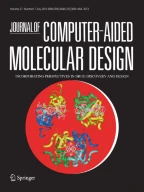Abstract
The half maximal response of any compound in a biological system is a fundamental measure of the compound’s potency whether the activity of the compound is beneficial or detrimental. As such, the estimation of this response as an Ec50 or an Ic50 results in a value that has fundamental significance in the determination of the potential of a compound. A collection of these values provide an invaluable data framework for understanding structure–activity relationships and computational method development and benchmarking. Therefore, understanding the errors and reproducibility issues associated with Ic50 determinations is essential for their robust calculation. This paper will discuss the practical approaches to the use of the Levenberg–Marquardt minimization method to fit dose response data and evaluate the resultant data in a statistically rigorous way.
Similar content being viewed by others
References
Davenport AP, Russell FD (1996) Radioligand binding assays: theory and practice. In: Mather SJ (ed) Current directions in radiopharmaceutical research and development. Kluwer Academic Publishers, Dordrecht, pp 169–179
Tallarida RJ (2000) Drug synergism and dose-effect data analysis. Chapman and Hall/CRC, Boca Raton
Lutz M, Kenakin T (1999) Quantitative molecular pharmacology and informatics in drug discovery. Wiley, Cichester
Langmuir I (1918) The adsorption of gases on plane surfaces of glass, mica and platinum. J Am Chem Soc 40(9):1361–1403
Kunapuli P (2010) Ultra-high-throughput screening assays for GPCRs. In: Gilchrist A (ed.) GPCR molecular pharmacology and drug targeting. Wiley, Hoboken, p get start-get end
Hill AV (1910) The possible effects of the aggregation of the molecules of haemoglobin on its dissociation curves. Proc Physiol Soc 40:iv–vii
Bindslev N (2008) Hill in hell. Drug-acceptor interactions. Co-Action Publishing, Sweeden, pp 257–281
Nocedal J, Wright SJ (2006) Numerical optimization. Springer, New York
Meddings JB, Scott RB, Fick GH (1989) Analysis and comparison of sigmoidal curves: application to dose-response data. Am J Physiol 257(6 Pt 1):G982–G989
Bjõrck A (1996) Numerical methods for least squares problems. SIAM: Society for Industrial and Applied Mathematics, Philadelphia
Snyman JA (2005) Practical mathematical optimization: an introduction to basic optimization theory and classical and new gradient-based algorithms. Springer, New York
Kalman D (2002) Doubly recursive multivariate automatic differentiation. Math Mag 75(3):187–202
Desta F, Mac Siurtain MP, Colbert JJ (1999) Parameter estimation of nonlinear growth models in forestry. Silv Fenn 33(4):327–336
Levenberg K (1944) A method for the solution of certain non-linear problems in least squares. Q Appl Math 2:164–168
Marquardt DW (1963) An algorithm for least-squares estimation of nonlinear parameters. SIAM J Appl Math 11(2):431–441
Prism v6. GraphPad Software. San Diego
SigmaPlot v12.5. Systat Software. San Jose
Pipeline Pilot v9.0. Accelrys. San Diego
Evans M, Hastings N, Peacock B (2013) Statistical distributions. Wiley, New York
Press WH, Teukolsky SA, Vetterling WT, Flannery BP (1992) Numerical recipes in C. Cambridge University Press, Cambridge
Snedecor GW, Cochran WG (1989) Statistical methods. Iowa State University Press, Ames
Davison AC, Hinkley DV (1997) Bootstrap methods and their application. Cambridge University Press, Cambridge
Motulsky H, Christopoulos A (2003) Fitting models to biological data using linear and non-linear regression. Cambridge University Press, Cambridge
Bergeron C, Moore G, Krien M, Breneman CM, Bennett KP (2011) Exploiting domain knowledge for improved quantitative high-throughput screening curve fitting. J Chem Inf Model 51(11):2802–2820
DeLean A, Munson PJ, Rodbard D (1978) Simultaneous analysis of families of sigmoidal curves: application to bioassay, radioligand assay, and physiological dose-response curves. Am J Physiol 235(2):E97–102
Giraldo J, Vivas NM, Vila E, Badia A (2002) Assessing the (a)symmetry of concentration-effect curves: empirical versus mechanistic models. Pharmacol Ther 95(1):21–45
Gottschalk PG, Dunn JR (2005) The five-parameter logistic: a characterization and comparison with the four-parameter logistic. Anal Biochem 343(1):54–65
Moré JJ, Garbow BS, Hillstrom KE (1980) User guide for MINPACK-1. Argonne National Laboratory
CMinpack 1.3.2 (2013) http://devernay.free.fr/hacks/cminpack/index.html. Accessed 18 Dec 2013
Apache commons mathematics library 3.2 (2014) http://commons.apache.org/proper/commons-math/. Accessed 5 May 2014
Akaike H (1974) A new look at the statistical model information. IEEE Trans Automat Contr 19(6):716–723
Burnham KP, Anderson DR (2004) Multimodel inference understanding AIC and BIC in model selection. Sociol Method Res 33(2):261–304
Bardsley WG, McGinlay PB (1987) The use of non-linear regression analysis and the F test for model discrimination with dose-response curves data and ligand binding. J Theor Biol 126(2):183–201
Brown SP, Muchmore SW, Hajduk PJ (2009) Healthy skepticism: assessing realistic model performance. Drug Discov Today 14(7–8):420–427
Cumming G, Finch S (2005) Confidence intervals and how to read pictures of data. Am Psychol 60(2):170–180
Stouch TR (2012) The errors of our ways: taking account of error in computer-aided drug design to build confidence intervals for our next 25 years. J Comput Aided Mol Des 26(1):125–134
Kramer C, Kalliokosshi T, Gedek P, Vulpetti A (2012) The experimental uncertainty of heterogeneous public Ki data. J Med Chem 55(11):5165–5173
Acknowledgments
The author thanks Dr. Carleton Sage for critical review and assistance in proof reading.
Author information
Authors and Affiliations
Corresponding author
Rights and permissions
About this article
Cite this article
Jones, G. Fitting and handling dose response data. J Comput Aided Mol Des 29, 1–11 (2015). https://doi.org/10.1007/s10822-014-9752-0
Received:
Accepted:
Published:
Issue Date:
DOI: https://doi.org/10.1007/s10822-014-9752-0
